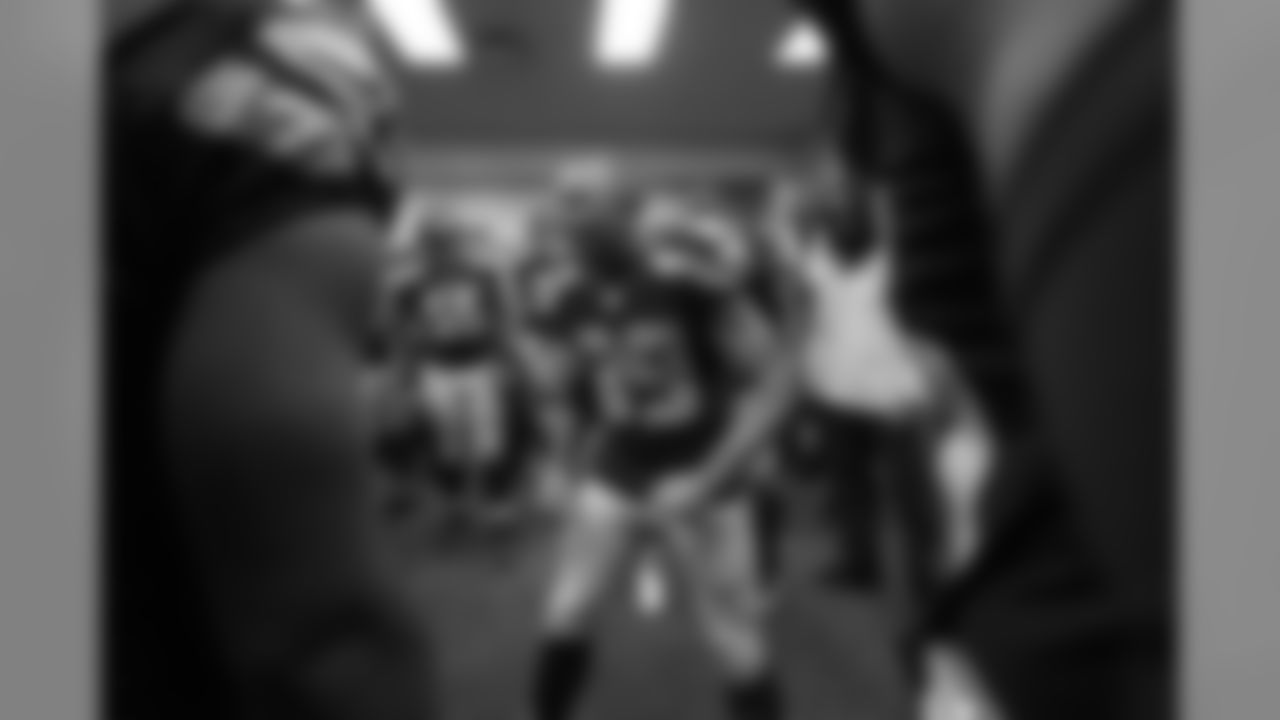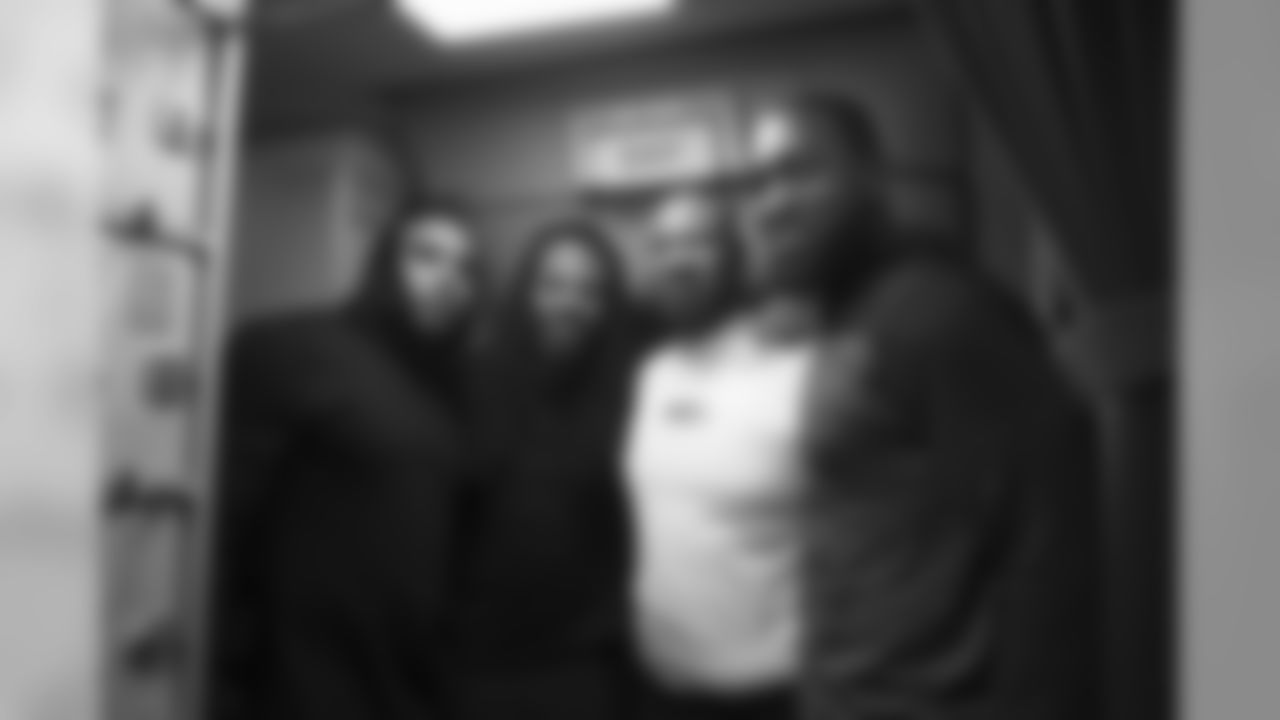Football season being over for the Seahawks means the busy season is just getting started for general manager John Schneider, who along with his scouting department and head coach Pete Carroll, will over the next few months shape what the Seahawks look like in 2016 though decisions they make in the draft, free agency and perhaps via trades.
Schneider went on 710 ESPN Seattle Friday to discuss what lies ahead for the Seahawks this offseason. Here are five things we learned from his conversation on the Brock and Salk Show.
1. The Seahawks plan to be aggressive, but smart this offseason.
As Schneider mentioned a couple of times in the interview, the Seahawks have 17 unrestricted free agents and seven restricted free agents on their roster, which means a lot of critical decisions await. Just as Carroll said on Monday, Schneider said they'd like to keep as much of the team intact as they can.
"We're a darn good football team," Schneider said. "We love our players. We have 17 unrestricted free agents coming up, and we're excited for the challenge of keeping this really cool puzzle together.
"We attack the offseason. We're going to attack it the same way we always have. Obviously we know what our deficiencies are, and we're going to try to compensate for those deficiencies as we go, but we're not going to crazy in one area and panic just because we think we're struggling there. We're going to be smart, we're going to be aggressive."
When it comes to being aggressive in free agency, that doesn't necessarily spending a ton of money on multiple players—"Now, we walk away from, shoot 70 percent of (free agent negotiations), maybe 80 percent of them," Schneider said—but rather being aggressive to understand the market, or "knowing what the Jones' are doing." Schneider pointed out that doing that in the past allowed Seattle to add Cliff Avril and Michael Bennett in the 2013 offseason well after free agency had kicked off, and Ahtyba Rubin last year.
"We've got our work cut out for us, but we're really excited about it," Schneider said. "We're all really excited about the future in terms of where we are in terms of the core guys we have battled to have under contract over the last couple of years, the core of leaders on this team, but also our young class that just came in. There are several players people don't even know about yet, we're excited for people to get to see those guys."
As for the large free agent class from the 2015 team, Schneider is realistic enough to know that it's not feasible to keep everyone, even the players they really like. Schneider mentioned past Seahawks like Byron Maxwell, Walter Thurmond, Golden Tate, Breno Giacomini and James Carpenter as examples.
"We know there are going to unrestricted players that we have where we're going to give it a go, we're going to give it a great run to try to keep them, but we know we're going to have to make a decision that we can only go to this area, then after that it's like, 'hey congratulations man.'" Schneider said.
2. Depth on the 53-man roster isn't enough.
When it comes to roster depth in the NFL, most casual observers would point to the talent on a team's 53-man roster, but Schneider is looking for more than that. As Schneider told Carroll in one of their earliest meetings in 2010, one of his goals was to build a team where the players they cut in August and September are sought after by other teams. That vision fully came to fruition in 2013, when 21 players who spent time with the Seahawks in the offseason and training camp played for other teams that season.
Having that kind of depth every year is almost impossible in a league set up to foster parity, but it's still a goal Schneider continues to chase.
"We don't talk about the 53, we talk about 80, and doing whatever we can to improve that 80," he said. "With our group, in terms of the acquisition and how we put the team together, we want to have the best competition at every position so that it's incredibly hard for coaches to make decisions. Two years ago, when we got to 53, throughout that season, we had 21 players that were here that we had let go who played for other teams that season. That's when people are chasing you, that's when you know you have a darn good roster. That's what we need to get back."
Schneider understands that having that kind of depth year in and year out isn't easy. Winning means being at or near the bottom of the draft order and the waiver claim order, and a salary cap makes it hard to keep all the young talent they develop, especially when other team become more and more interested in players developed by a winning team. But those realities won't stop the Seahawks from seeking that 80-man depth.
"Now this league is built on parity, it's built on trying to rip apart teams once they're built," Schneider said. "Drafting low and claiming low, and that's great, you don't want to be drafting high and at the top of the claiming order… We use that as a badge of honor."
[wysifield-embeddedaudio|eid="368891"|type="embeddedaudio"|view_mode="full"]
3. Schneider likes what his team was able to overcome, but feels like Seattle should still be playing.
Schneider was asked during the interview if he felt like the Seahawks underachieved this season, and it wasn't an easy question to answer. On one hand, the Seahawks had been to two straight Super Bowls, making expectations as high as they could be, so losing in the divisional round felt like coming up short. But on the other hand, the Seahawks struggled so much early this season, falling to 2-4 at one point, that the way they responded in order make the playoffs showed a lot about the team's resilience.
"I still feel like we still should be playing," Schneider said. "What we had to overcome early in the season, starting in St. Louis, going to Green Bay—that's a tough start—I just like the way the team came together. I look at it like, this is a team that's been to two Super Bowls in a row and five playoff appearances in in six years, so our expectations are very high, so yeah, to I would say (we did underachieve) to a certain extent."
4. The Seahawks want to get tougher this offseason.
When Schneider and Carroll first arrived in Seattle, Schneider looked at teams like Pittsburgh, Baltimore and San Francisco as models when it came to physical play.
"I remember when we got here, we talked about being a team that could go play anybody anywhere," Schneider said. "… At the time, the 'Niners in our division and (Pittsburgh and Baltimore) were clearly the most physical teams in the league. That's where we want to be, we want to be the bully. We don't want to get knocked around. We want to be bringing it all the time."
The Seahawks eventually became that team, though Schneider noted that this year, "There were times we were and there were times we weren't. That just goes along with some of our inconsistencies this year."
So when it comes to evaluating players this offseason, finding players who can help build up that toughness will be a priority, just as it is every year.
"That's our goal from a pure football acquisition—that's what I talk with our people about all the time—we talk about being tough, smart and reliable all the time," Schneider said. "Who are the players who are going to play hard, who are going to come bring it, are going to be able to survive in the locker room with real strong personalities and compete with those guys, and stand next to them side by side in the trenches? That's definitely what we're looking for."
5. Schneider addressed the futures of Jimmy Graham and Marshawn Lynch.
While Jimmy Graham's knee injury cut short his first season in Seattle, Schneider didn't have as negative of a view on Graham's year as a lot of people do.
"Jimmy had a great offseason," Schneider said. "I thought he had a great camp. Personally, I think people were a little hard on Jimmy. He started going when our offense started going. I look at it as just part of our maturation of our offense. I don't look at it like he wasn't the Jimmy of old. You're talking about a guy that gets doubled and bracket all the time. When you try forcing an offense, you try developing an offense around one person, that's when you run into trouble... This guy's a phenomenal football player. I understand why people would say, 'Why didn't he come in here and take the offense to another level early on?' But I think the whole offensive unit, we were just trying to find our way early on."
And Schneider also put to bed any notion of the Seahawks not bringing Graham back in 2016, saying yes when asked if there was "no question" about Graham being back.
The future on another star offensive player, running back Marshawn Lynch, is less clear, however. Lynch is under contract for next year, but has hinted in the past at retirement, and Schneider said that could be what ends up happening, though he prefaced his comments with, "I would have no idea" what Lynch will do.
"I know we're going to treat him with as much respect as we possibly can here," Schneider said. "Give him a little leeway to find his way in terms of what he wants to do. But I'm under the impression that he's leaning towards retirement."
Team photographer Rod Mar shot what turned out to be his final photo essay of the 2015 season, as the Seahawks traveled to North Carolina and fell to the Panthers in the NFC Divisional round of the NFL Playoffs.

12s lined the streets near VMAC and along S. 188th Street near Sea-Tac Airport to wish the Seahawks well as they embarked on the trip to face the Carolina Panthers in the divisional round of the playoffs.

Bobby Wagner walks up the stairs to the rear door of the team's Delta charter for the long flight to Charlotte, North Carolina.

Five hours later, Seahawks quarterback Russell Wilson walks across the tarmac after disembarking from the team's charter in North Carolina.

On Saturday, receivers Jermaine Kearse and Tyler Lockett found a moment to relax before boarding the buses to the team's walk-thru.

Offensive linemen Russell Okung, Garry Gilliam and Justin Britt share a laugh before the start of walk-thru.

Offensive players Luke Willson, Christine Michael, Marshawn Lynch and Cooper Helfet enjoy a light-hearted moment before walk-thru.

Offensive tackle Garry Gilliam plays a hand-eye coordination game with Tyler Lockett, Russell Wilson, Patrick Lewis and Justin Britt before the start of walk-thru.

The offense takes their place during part of Saturday's walk-thru.

Seahawks helmets, uniforms and equipment hang in the players lockers in the visitors locker room at Bank of America Stadium, home of the Panthers.

Receiver Tyler Lockett listens to music on the bus ride back from Saturday's walk-thru.

Game day brought snow flurries early in the morning, and DeShawn Shead, Cassius Marsh and team doctor Jonathan Drezner made their way to the buses.

At the stadium, 12s were waiting with suitably sized 12 flags after the Panthers established a rule on size of flags within the stadium at games.

Led by strong safety Kam Chancellor, the Seahawks defensive backs run onto the field for pregame warmups.

Head coach Pete Carroll chats with quarterback Russell Wilson as the team does its pregame stretching.

Head coach Pete Carroll takes a moment during pregame to visit with seven-year old Ade Lewis, a die-hard Seahawks fans from North Carolina who was being teased at school for being a 12. The team invited Lewis and his family to the game where they watched pregame from the sidelines and got a visit from Coach Carroll and other players.

Head coach Pete Carroll paces behind his team as they work on the 11-on-11 portion of pregame warmups in Carolina.

Quarterback Russell Wilson greets teammates and coaches as they head back into the locker room after pregame warmups.

Receiver Doug Baldwin finds a quiet corner to himself in the locker room before the game. The large 12 flag on the wall was signed by fans in Seattle on Friday at Blue Friday rallies then sent with the team on the charter.

Seahawks long-snapper Clint Gresham pauses during the hustle and bustle of the locker room before the game.

Linebacker Bruce Irvin listens to music in the final moments before the game.

Defensive tackle Brandon Mebane gathers his teammates around him and shares some final words before the team takes the field.

Captains Bobby Wagner, Russell Wilson and Jon Ryan head to midfield for the pregame coin toss.

The Seahawks were stunned when Carolina's Jonathan Stewart raced 59 yards on the first play from scrimmage to set up the Panthers first touchdown.

On the ensuing series, Justin Britt walked back to the sideline after Carolina's Luke Kiechly returned an interception for a touchdown and the Seahawks found themselves in a 14-0 hole less than five minutes into the game.

Carolina's Kawaan Short celebrates after sacking Seattle's Russell Wilson in the first quarter.

Seattle's defense continued to hit hard as Jeremy Lane, Kam Chancellor and Michael Bennet forced Carolina's Mike Tolbert to lose his helmet on this play.

Carolina's Jonathan Stewart leaps over the pile to score the Panthers' third touchdown of the first half on their way to what would eventually become a 31-0 halftime lead.

Seattle's Michael Bennett sacked Carolina's Cam Newton as the defense continued to pressure.

Seattle's offense began to come alive as receiver Doug Baldwin, as he did in the playoff game in Minnesota, leapt high to snag a pass for a first down.

Seattle's Russell Wilson escapes the grasp of Carolina's Kawaan Short on a scramble up the middle.

Seattle's Bobby Wagner flies into finish a tackle with Earl Thomas as they stop Carolina's Mike Tolbert.

At halftime, quarterback Russell Wilson talked to receivers Tyler Lockett and Doug Baldwin in the locker room.

Defensive coordinator Kris Richard gives halftime instructions.

On the other side of the locker room, assistant head coach Tom Cable addresses the offense.

Before the team returned to the field, receiver Doug Baldwin gave an impassioned speech to his teammates.

Seahawks return specialist Tyler Lockett sparked the second half with a 50-yard kickoff return.

Seahawks receiver Kevin Smith stretches the ball out at the end of a seven-yard gain in the third quarter.

Seattle's Jermaine Kearse stretches high to catch a pass from Russell Wilson for the Seahawks first score of the game, cutting the lead to 31-7 after the extra point.

Seahawks receiver Doug Baldwin grimaces as he can't quite reach a deep ball from Russell Wilson in the third quarter.

Turf flies as Seattle quarterback Russell Wilson slides to avoid being hit on a scramble.

Seattle's Tyler Lockett got open of the right side of the end zone and made this 33-yard reception to cut Carolina's lead to 31-14.

Seahawks quarterback Russell Wilson fires a pass over the middle as Justin Britt blocks the Kawaan Short of the Panthers.

Seahawks running back Marshawn Lynch saw his first action since being sideline by injury and took on Carolina's Cortland Finnegan in the open field.

Tight end Luke Willson can't grasp a pass just out of his reach in the end zone in the fourth quarter.

Seattle's Jermaine Kearse leaps to catch a three-yard touchdown pass from Russell Wilson and the Seahawks cut the lead to 31-21.

Seattle head coach Pete Carroll celebrates after he watched his team score 21 unanswered points to cut the lead to 31-21 in the fourth quarter.

Carolina quarterback Cam Newton reacts on the sidelines after watching the Seahawks cut the lead to ten points at 31-21 in the fourth quarter.

Offensive coordinator Darrell Bevell consults with quarterback Russell Wilson during a break in the action.

Seattle kicker Steven Hauschka and holder Jon Ryan watch as Hauschka's 36-yard field goal with 1:16 left in the game cut the lead to 31-24.

Needing the ball back trailing by seven, Seattle tried an onside kick which was recovered by the Panthers, ending the Seahawks valiant comeback.

Head coach Pete Carroll stalks the sidelines in the final moments of the game.

Seahawks receiver Jermaine Kearse reacts as he walks onto the field after the loss to the Panthers.

Receivers coach Dave Canales hugs Doug Baldwin on the Seahawks sideline after the final whistle.

Panthers coach Ron Rivera shakes hands with Seahawks running back Marshawn Lynch after the game.

Quarterback Russell Wilson holds hands with players of both teams in the postgame prayer.

Head coach Pete Carroll addresses his team in the locker room after the season-ending loss.

Seahawks players listen as head coach Pete Carroll addresses them after the game.

Head coach Pete Carroll reaches his hand together with his players and assistant coaches at the end his postgame address to the team.

The Seahawks join hands in the locker room for the last time in the 2015 season after falling to Carolina, 31-24 in the divisional round of the playoffs.

Safety Earl Thomas was the last player left in the locker room, and remained dressed in his uniform well after the last player had left.

Players and coaches walk from the bus to the airplane as the team departed for Seattle after the loss to the Panthers.

On the plane ride home, Hall-of-famer Cortez Kennedy spoke with, then asked for a photo with current defensive standouts Bobby Wagner, Richard Sherman and Kam Chancellor.

12s lined the streets to greet the team and show their support on Sunday night after the plane landed back in Seattle.

Fans also gathered outside of the VMAC to greet the Seahawks upon their return to the team's headquarters.






